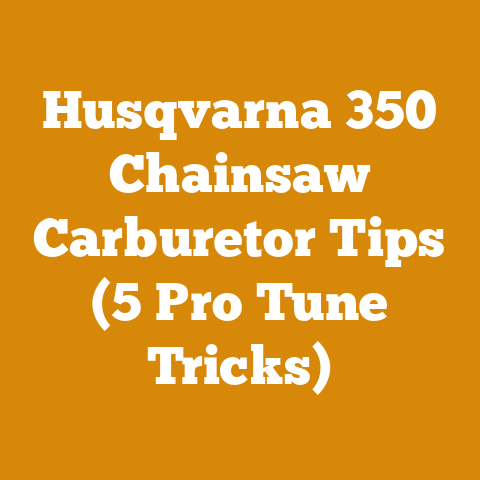Weeds and Brush Control (5 Expert Tools for Efficient Clearing)
WARNING: Weeds and brush control can be dangerous. Always wear appropriate safety gear, including eye protection, gloves, and sturdy footwear. Understand the tools and techniques described herein before attempting any clearing work. Improper use of equipment can lead to serious injury or death. Always consult local regulations and guidelines regarding vegetation removal and herbicide use.
Weeds and Brush Control: 5 Expert Tools for Efficient Clearing
As someone who’s spent years wrestling with unruly weeds and stubborn brush, I know firsthand the frustration of reclaiming land. Whether you’re prepping for a vegetable garden, clearing a firebreak, or simply trying to tame an overgrown property, the right tools can make all the difference. I’ve learned the hard way that a dull blade or the wrong approach can turn a simple task into a back-breaking ordeal. This guide is born from my own experiences, research, and a few close calls, offering practical advice and technical insights to help you efficiently conquer your weed and brush control challenges.
Understanding the Challenge: Why Control Weeds and Brush?
Before diving into the tools, let’s quickly address why weed and brush control is so important. Beyond aesthetics, unchecked vegetation can:
- Compete with desirable plants: Weeds steal sunlight, water, and nutrients, hindering the growth of gardens, crops, and even valuable trees.
- Increase fire risk: Dry brush and weeds are prime fuel for wildfires, especially in arid climates. Maintaining a clear perimeter around structures is crucial for fire safety.
- Harbor pests and diseases: Overgrown areas can become breeding grounds for insects, rodents, and plant diseases, impacting both gardens and human health.
- Obstruct access and visibility: Dense vegetation can make it difficult to navigate your property, hindering maintenance and posing safety hazards.
I’ve personally witnessed the devastating effects of uncontrolled brush fires, and the frustration of watching my vegetable garden struggle against a sea of weeds. Effective weed and brush control is an investment in the health, safety, and usability of your land.
1. The Mighty Chainsaw: A Brush Clearing Workhorse
No discussion of brush control is complete without mentioning the chainsaw. While often associated with felling large trees, chainsaws are incredibly versatile for clearing thick brush and small trees.
Technical Specifications and Requirements:
- Chainsaw Type: For most brush clearing tasks, a lightweight gas-powered chainsaw with a 14-16 inch bar is ideal. Electric chainsaws are suitable for smaller areas and lighter brush.
- Engine Size: A 30-40cc engine provides sufficient power for cutting through most brush and small trees up to 8 inches in diameter.
- Chain Type: A low-kickback chain is highly recommended for safety, especially for inexperienced users.
- Safety Features: Look for chainsaws with chain brakes, throttle interlocks, and anti-vibration systems.
- Fuel Mixture: Always use the correct fuel-to-oil mixture specified by the chainsaw manufacturer. Typically, this is a 50:1 ratio (gasoline to two-stroke oil). Using the wrong mixture can damage the engine.
- Chain Tension: Maintain proper chain tension. A loose chain can derail and cause injury, while an overtight chain can overheat and wear out prematurely. The chain should be snug against the bar but still able to be pulled around by hand.
- Sharpening: Keep the chain sharp. A dull chain requires more force, increases the risk of kickback, and produces rough cuts. Sharpen the chain regularly with a chainsaw file or grinder.
- Personal Protective Equipment (PPE): Essential PPE includes:
- Chainsaw chaps: Provide crucial protection for your legs.
- Eye protection: Safety glasses or a face shield are a must.
- Hearing protection: Earplugs or earmuffs to protect your hearing from the loud noise of the chainsaw.
- Gloves: Sturdy work gloves to improve grip and protect your hands.
- Steel-toed boots: Provide foot protection.
- Helmet: A helmet is essential, especially when felling small trees.
Data Points and Statistics:
- Kickback: Chainsaw kickback is a leading cause of chainsaw injuries. According to the Consumer Product Safety Commission (CPSC), chainsaws cause approximately 36,000 injuries each year in the United States.
- Chain Speed: Chainsaw chain speeds typically range from 40 to 60 miles per hour.
- Fuel Consumption: A typical 30-40cc chainsaw will consume approximately 0.25 to 0.5 gallons of fuel per hour, depending on the load.
Personalized Storytelling and Unique Insights:
I remember one particularly challenging brush clearing project where I was tasked with reclaiming a heavily overgrown area near a property line. The area was choked with thorny bushes, tangled vines, and small saplings. Initially, I tried using a brush cutter, but it was simply too slow and ineffective against the thicker stems. That’s when I brought out the chainsaw. The key was to use a strategic approach. I started by carefully cutting the larger saplings at ground level, then used the chainsaw to clear away the tangled brush in sections. I paid close attention to the direction of fall to avoid damaging the fence or any nearby structures. It was hard work, but the chainsaw made the job significantly faster and more efficient.
Case Study: Clearing a Firebreak
I recently assisted a homeowner in clearing a firebreak around their property in a fire-prone area. The firebreak was designed to create a barrier of cleared land to slow the spread of wildfires. The technical requirements for the firebreak were:
- Width: A minimum width of 10 feet, cleared down to bare earth.
- Vegetation Removal: All flammable vegetation, including grass, weeds, brush, and trees, must be removed.
- Ground Cover: The cleared area must be maintained free of flammable debris.
I used a combination of a chainsaw, brush cutter, and hand tools to clear the firebreak. The chainsaw was particularly effective for removing small trees and thick brush. I carefully felled the trees, ensuring they fell away from the property. I then used the chainsaw to cut the trees into manageable pieces for removal. The brush cutter was used to clear away smaller brush and grass. Finally, I used hand tools to remove any remaining vegetation and debris.
Practical Tips and Best Practices:
- Assess the Area: Before starting, carefully assess the area to be cleared. Identify any hazards, such as rocks, fences, or underground utilities.
- Plan Your Cuts: Plan your cuts carefully to avoid pinching the chain or causing the tree to fall in an unintended direction.
- Use Proper Cutting Techniques: Use proper cutting techniques to minimize kickback and ensure safe operation. Never cut above shoulder height.
- Maintain Your Chainsaw: Regularly clean and maintain your chainsaw to ensure optimal performance and longevity.
2. The Brush Cutter: Precision and Power for Smaller Growth
Brush cutters, also known as clearing saws or weed eaters with blades, are ideal for tackling dense weeds, tall grass, and small brush that’s too thick for a standard lawnmower but not quite chainsaw territory.
Technical Specifications and Requirements:
- Engine Type: Brush cutters are available with gas-powered or electric motors. Gas-powered models offer more power and portability, while electric models are quieter and more environmentally friendly.
- Engine Size: Gas-powered brush cutters typically have engines ranging from 25cc to 50cc. A 30-40cc engine is sufficient for most brush clearing tasks.
- Cutting Head: Brush cutters can be equipped with a variety of cutting heads, including:
- String Trimmer Head: For light-duty trimming of grass and weeds.
- Brush Blade: A multi-toothed steel blade for cutting thicker brush and small saplings.
- Circular Saw Blade: A more aggressive blade for cutting thicker trees and woody vegetation.
- Shaft Type: Brush cutters are available with straight or curved shafts. Straight shafts offer better reach and are preferred for heavier-duty tasks.
- Harness: A comfortable harness is essential for supporting the weight of the brush cutter and reducing fatigue.
- Safety Features: Look for brush cutters with throttle interlocks, blade guards, and anti-vibration systems.
- Personal Protective Equipment (PPE): Essential PPE includes:
- Eye protection: Safety glasses or a face shield are a must.
- Hearing protection: Earplugs or earmuffs to protect your hearing from the loud noise of the brush cutter.
- Gloves: Sturdy work gloves to improve grip and protect your hands.
- Leg Protection: Chaps or sturdy pants to protect your legs from flying debris.
- Steel-toed boots: Provide foot protection.
Data Points and Statistics:
- Blade Speed: Brush cutter blade speeds typically range from 5,000 to 10,000 RPM.
- Cutting Capacity: Brush cutters with brush blades can typically cut through vegetation up to 2-3 inches in diameter.
- Fuel Consumption: A typical 30-40cc gas-powered brush cutter will consume approximately 0.2 to 0.4 gallons of fuel per hour, depending on the load.
Personalized Storytelling and Unique Insights:
I once had a client who wanted to clear a large patch of overgrown weeds and brush in their backyard. The area was too large for a standard weed eater, but not quite dense enough to warrant a chainsaw. I decided to use a brush cutter with a brush blade. The key was to use a sweeping motion, cutting the vegetation close to the ground. I also had to be careful to avoid hitting any rocks or other obstacles, as this could damage the blade. The brush cutter made quick work of the weeds and brush, leaving the area clean and ready for planting.
Case Study: Controlling Invasive Species
A local conservation group hired me to help control an invasive species of brush that was threatening a native plant community. The technical requirements for the project were:
- Species Identification: Accurately identify the invasive species.
- Selective Removal: Remove only the invasive species, leaving the native plants intact.
- Disposal: Dispose of the removed vegetation properly to prevent re-infestation.
I used a brush cutter with a brush blade to selectively remove the invasive brush. The key was to carefully identify the invasive species and avoid cutting any of the native plants. I also had to be careful to dispose of the removed vegetation properly to prevent re-infestation. I loaded the cut brush into a trailer and hauled it to a designated composting facility.
Practical Tips and Best Practices:
- Choose the Right Blade: Select the appropriate blade for the type of vegetation you are cutting. A string trimmer head is suitable for light-duty trimming, while a brush blade is better for thicker brush.
- Maintain the Blade: Keep the blade sharp. A dull blade requires more force and increases the risk of kickback. Sharpen the blade regularly with a file or grinder.
- Use Proper Cutting Techniques: Use proper cutting techniques to minimize kickback and ensure safe operation. Always keep both hands on the handles.
- Clear the Area: Before starting, clear the area of any obstacles, such as rocks, fences, or underground utilities.
3. The Hand Axe or Hatchet: Precision and Control for Smaller Tasks
For smaller, more targeted brush control, a hand axe or hatchet is an invaluable tool. These are perfect for pruning small branches, clearing vines, and removing individual weeds with woody stems.
Technical Specifications and Requirements:
- Axe/Hatchet Type: A hatchet is generally smaller and lighter than a hand axe, making it ideal for one-handed use. A hand axe is larger and heavier, providing more power for chopping.
- Head Weight: Hatchets typically have a head weight of 1-2 pounds, while hand axes have a head weight of 2-3 pounds.
- Handle Length: Hatchets typically have a handle length of 12-16 inches, while hand axes have a handle length of 18-24 inches.
- Steel Type: Look for axes and hatchets made from high-carbon steel for durability and edge retention.
- Handle Material: Handles are typically made from wood (hickory or ash) or synthetic materials (fiberglass or composite). Wood handles offer a traditional feel and can be replaced if broken, while synthetic handles are more durable and resistant to moisture.
- Edge Angle: The edge angle of an axe or hatchet should be appropriate for the type of wood being cut. A steeper angle is better for splitting wood, while a shallower angle is better for chopping.
- Safety Features: Look for axes and hatchets with a secure head-to-handle connection and a comfortable grip.
- Personal Protective Equipment (PPE): Essential PPE includes:
- Eye protection: Safety glasses or a face shield are a must.
- Gloves: Sturdy work gloves to improve grip and protect your hands.
- Sturdy Footwear: Steel-toed boots are recommended for added protection.
Data Points and Statistics:
- Impact Force: The impact force of an axe or hatchet depends on the weight of the head, the length of the handle, and the force of the swing.
- Edge Hardness: The hardness of the steel used in the axe or hatchet head is measured on the Rockwell scale. A hardness of 55-60 HRC is ideal for edge retention and durability.
- Handle Strength: The handle of an axe or hatchet should be able to withstand significant stress without breaking.
Personalized Storytelling and Unique Insights:
I’ve always appreciated the simplicity and effectiveness of a good hand axe. I remember one time when I was clearing a trail through a wooded area. I encountered a number of small saplings and vines that were blocking the path. A chainsaw would have been overkill for such small tasks, so I relied on my trusty hand axe. With a few well-placed swings, I was able to quickly clear the trail and continue on my way.
Case Study: Pruning Fruit Trees
I recently helped a homeowner prune their fruit trees. The technical requirements for the project were:
- Proper Pruning Techniques: Use proper pruning techniques to promote healthy growth and fruit production.
- Disease Prevention: Prevent the spread of disease by disinfecting pruning tools between cuts.
- Wound Sealing: Seal large pruning wounds with a tree wound sealant to prevent infection.
I used a hand axe and pruning shears to prune the fruit trees. The hand axe was used to remove larger branches, while the pruning shears were used to remove smaller branches and twigs. I carefully followed proper pruning techniques, removing dead, diseased, and crossing branches. I also disinfected my tools between cuts to prevent the spread of disease. Finally, I sealed any large pruning wounds with a tree wound sealant to prevent infection.
Practical Tips and Best Practices:
- Sharpen the Blade: Keep the blade sharp. A dull blade requires more force and increases the risk of injury. Sharpen the blade regularly with a file or whetstone.
- Use Proper Techniques: Use proper chopping techniques to maximize power and minimize the risk of injury. Always keep your feet firmly planted and swing the axe or hatchet in a controlled manner.
- Protect Yourself: Wear appropriate safety gear, including eye protection, gloves, and sturdy footwear.
- Maintain Your Tools: Regularly clean and maintain your axe or hatchet to ensure optimal performance and longevity.
4. The Weed Torch: A Flame-Based Solution
Weed torches offer a non-chemical approach to weed control, using intense heat to kill weeds quickly and efficiently. They are particularly effective for clearing weeds from cracks in pavement, gravel driveways, and other areas where manual removal is difficult.
Technical Specifications and Requirements:
- Torch Type: Weed torches are available in propane and butane models. Propane torches are more powerful and produce a hotter flame, while butane torches are lighter and more portable.
- BTU Output: The BTU (British Thermal Unit) output of a weed torch determines its heating power. Higher BTU outputs result in a hotter flame and faster weed kill. Weed torches typically have BTU outputs ranging from 20,000 to 500,000 BTU.
- Flame Adjustability: Look for weed torches with adjustable flame controls to customize the flame intensity for different weed types and conditions.
- Ignition System: Weed torches are available with manual or automatic ignition systems. Automatic ignition systems are more convenient and eliminate the need for a lighter or match.
- Safety Features: Weed torches should have safety features such as a flame guard, a pressure relief valve, and a shut-off valve.
- Fuel Source: Weed torches typically use propane or butane cylinders. The size of the cylinder determines the burn time.
- Personal Protective Equipment (PPE): Essential PPE includes:
- Eye protection: Safety glasses or a face shield are a must.
- Gloves: Heat-resistant gloves to protect your hands from the heat of the torch.
- Long Sleeves and Pants: To protect your skin from burns.
- Sturdy Footwear: Leather boots are recommended for added protection.
Data Points and Statistics:
- Flame Temperature: Weed torch flames can reach temperatures of up to 2,000 degrees Fahrenheit.
- Burn Time: The burn time of a weed torch depends on the BTU output and the size of the fuel cylinder. A typical propane weed torch with a 20-pound cylinder can burn for several hours.
- Fuel Consumption: Weed torches typically consume propane or butane at a rate of 1-2 pounds per hour.
Personalized Storytelling and Unique Insights:
I’ve found weed torches to be particularly useful for controlling weeds in gravel driveways and walkways. These areas are difficult to weed manually, and herbicides can be harmful to the environment. A weed torch provides a quick and effective way to kill weeds without the use of chemicals.
Case Study: Clearing Weeds from Pavement Cracks
A local municipality hired me to help clear weeds from pavement cracks in a downtown area. The technical requirements for the project were:
- Complete Weed Kill: Kill all weeds in the pavement cracks.
- Prevent Damage to Pavement: Avoid damaging the pavement with the torch.
- Minimize Smoke and Odor: Minimize smoke and odor to avoid disturbing pedestrians and businesses.
I used a propane weed torch to clear the weeds from the pavement cracks. The key was to use a low flame and move the torch slowly over the weeds. This allowed the heat to penetrate the weeds and kill them without damaging the pavement. I also took care to minimize smoke and odor by using a clean-burning propane cylinder and avoiding over-heating the weeds.
Practical Tips and Best Practices:
- Use Caution: Weed torches produce a very hot flame and should be used with caution. Always follow the manufacturer’s instructions and wear appropriate safety gear.
- Avoid Flammable Materials: Keep the torch away from flammable materials, such as dry grass, brush, and buildings.
- Use a Low Flame: Use a low flame to avoid damaging the pavement or other surfaces.
- Move the Torch Slowly: Move the torch slowly over the weeds to allow the heat to penetrate and kill them.
- Extinguish the Flame: Always extinguish the flame completely when you are finished using the torch.
5. Manual Weed Removal Tools: Precision for Sensitive Areas
Sometimes, the best approach is the simplest. Manual weed removal tools, such as hoes, weed pullers, and hand trowels, offer precision and control for removing weeds in sensitive areas, such as flower beds and vegetable gardens.
Technical Specifications and Requirements:
- Tool Type: A variety of manual weed removal tools are available, including:
- Hoes: Used for cutting weeds at the soil surface.
- Weed Pullers: Used for pulling weeds out of the ground, roots and all.
- Hand Trowels: Used for digging up weeds and loosening soil.
- Cultivators: Used for tilling soil and removing small weeds.
- Steel Type: Look for tools made from high-carbon steel for durability and rust resistance.
- Handle Material: Handles are typically made from wood (ash or hickory) or synthetic materials (fiberglass or composite). Wood handles offer a traditional feel, while synthetic handles are more durable and resistant to moisture.
- Ergonomics: Choose tools with ergonomic handles that are comfortable to grip and use for extended periods.
- Sharpness: Keep the blades of hoes and cultivators sharp for efficient weed removal.
- Personal Protective Equipment (PPE): Essential PPE includes:
- Gloves: Sturdy work gloves to protect your hands.
- Knee Pads: For kneeling comfortably while weeding.
- Sturdy Footwear: Provide foot protection.
Data Points and Statistics:
- Weed Removal Efficiency: The efficiency of manual weed removal tools depends on the type of tool, the type of weed, and the soil conditions.
- Ergonomic Design: Ergonomic tools can reduce strain and fatigue, allowing you to weed for longer periods without discomfort.
- Durability: High-quality manual weed removal tools can last for many years with proper care and maintenance.
Personalized Storytelling and Unique Insights:
I’ve always found that hand weeding is a therapeutic way to connect with my garden. There’s something satisfying about carefully removing weeds and seeing the fruits of your labor. I’ve also learned that hand weeding is often the most effective way to control weeds in sensitive areas where herbicides cannot be used.
Case Study: Maintaining a Vegetable Garden
I recently helped a homeowner maintain their vegetable garden. The technical requirements for the project were:
- Weed-Free Garden: Keep the garden free of weeds to promote healthy plant growth.
- Soil Health: Maintain healthy soil conditions by avoiding the use of herbicides and pesticides.
- Crop Rotation: Rotate crops annually to prevent soil depletion and pest infestations.
I used a combination of manual weed removal tools to maintain the vegetable garden. I used a hoe to cut weeds at the soil surface, a weed puller to remove weeds with deep roots, and a hand trowel to dig up weeds and loosen soil. I also avoided the use of herbicides and pesticides to maintain healthy soil conditions. Finally, I rotated crops annually to prevent soil depletion and pest infestations.
Practical Tips and Best Practices:
- Weed Early and Often: Weed early and often to prevent weeds from becoming established.
- Remove Weeds Completely: Remove weeds completely, including the roots, to prevent them from growing back.
- Use the Right Tool: Use the right tool for the job. A hoe is best for cutting weeds at the soil surface, while a weed puller is better for removing weeds with deep roots.
- Maintain Your Tools: Regularly clean and maintain your tools to ensure optimal performance and longevity.
Conclusion: Choosing the Right Tool for the Job
Effective weed and brush control requires a combination of knowledge, skill, and the right tools. By understanding the technical specifications and requirements of each tool, you can choose the best option for your specific needs and achieve efficient and long-lasting results. Remember to prioritize safety, follow best practices, and always consult local regulations before undertaking any vegetation removal project. With the right approach, you can reclaim your land and enjoy a weed-free and brush-free environment.






